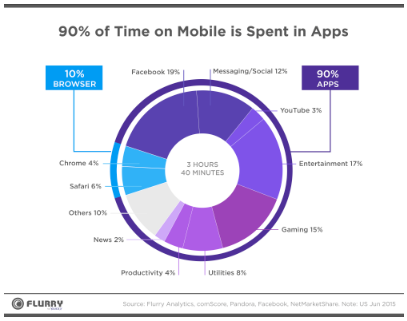By 2020 it is projected there will be nearly 21 billion internet-connected devices, or "things" in the world.
The explosive ubiquity of this mobile-connected technology has led people to depend on these devices more regularly, with 94 percent of smartphone users claiming that they carry their phones with them frequently and 82 percent reporting that they never, or rarely, turn their phones off.
These numbers fall in line with a trend that is longer-standing, with Morgan Stanley reporting as early as 2011 that 91 percent of mobile users have some kind of mobile device within arm's reach 100 percent of the time.
Corresponding with this increase in mobile device usage is the rise of what is called "voice search," as well as the increasing prevalence of devices that contain "personal assistant" software like Alexa and Siri. People have become increasingly accustomed to the idea of speaking directly with computer devices and accessing information on the internet wherever and whenever they might need it. Naturally, like mobile usage in general, these emergent technologies have begun to influence search, and the impact will likely become even more apparent as usage grows.
Much in the way mobile devices have disrupted search by bringing on-the-go, local queries and results into the equation, voice search is introducing new methods of query and different results-experiences for users. Now, when a person activates voice search, particularly on personal assistant devices, most personal assistant technology will only deliver what is considered the best answer, essentially reducing the SERP to one result. That means that brands either occupy the first position, or, as far as voice search is concerned, they do not receive any attention at all.
Of course, the single-result SERP isn't uniformly true for voice search. For voice-activated technologies connected to visual displays like smartphones and laptops, there is a greater possibility for more results. Even so, brands still need to remain focused on appearing in the top results. When someone uses voice search because they are on-the-go or they need an immediate answer, they don't intend to scroll through pages. Rather, they're looking for Google rich answers, such as a Quick Answer (which provides a high-quality, immediate answer to a query), Rich Card (information-rich content previews), or other top-featured results.

Google's new Rich Cards
Over the past few years, we have seen the transformative impact of mobile on search and consumer behavior, including the shift towards the mobile-first algorithm. Voice search is the next major trend that brands will need to focus on to ensure they remain competitive. The more we understand about voice search and personal assistant devices, the easier it will be to optimize for them and ensure that your brand is represented across devices.
The role of personal assistantsAs devices with artificially intelligent personal assistance software have become increasingly mainstream, so too has the use of voice search.
According to Google's Gary Illyes, the number of voice queries in 2015 doubled from the number in 2014. Developers are now beginning to understand there are particular types of search queries people are more fond of using voice for, rather than text. For example "when is my meeting?" Users are 30 times more likely to use voice for these types of queries, rather than text.
These personal assistants, which have been put forth by several different brands, have empowered customers to remain even more connected to the internet at all times, even when engaging in hands-on activities like cooking or driving. Customers can ask about the cook time for chicken, for example, while in the middle of preparing the meat without having to remove themselves from their original task.
Mary Meeker's Internet Trends Report looked at the reasons why customers use voice search, as well as which device settings are the most popular. The report indicated that the usefulness of voice search when a user's hands or vision were otherwise occupied was the top reason that people enjoyed the technology, followed by a desire for faster results and difficulty typing on certain devices.
Where do users access voice search? It turns out that, more often than not, consumers are opting to use voice-activated devices is at home, followed by the car and on-the-go.
These personal assistants, along with voice search in general, are creating an increasingly connected world where customers expect search to be ever-present and capable of addressing their needs immediately.

Artificial intelligence powers personal assistance capabilities for mobile users. AI helps voice search and the associated algorithms to better understand and account for user intent. This intelligence, using semantics, search history, user proclivities and other factors, is able to process and understand the likely context of queries and provide results accordingly.
Natural language triggers, such as "who," "what," "where," "when," "why," and "how," for example, make it easier for AI to understand the user's place on the customer journey and the likely goal of the search. Voice-activated devices can then direct users to where they most likely want to be on the web.
AI is essentially able to sift through voice search queries and identify the most important information, as well as the understand the intent regardless of an array of speech errors. For example, a query that changes direction mid-sentence, such as "How was the… what was the score to the White Sox game last night?" will be correctly answered. This enhances the conversational capabilities of the voice search, understanding the reason behind a query even if it is not asked in a precise way.
Voice search in practiceVoice search makes it even easier for customers to ask hyperlocal queries, which is significant in the context of a mobile-rich environment. Consider how users execute search queries differently when speaking to mobile devices rather than exploring the web via a desktop computer.
Voice searches tend to contain slightly different words, such as "close" or "nearby", which are not commonly used on desktop computers. Why? Because people tend to use mobile devices to access personal assistance software, and mobile devices are most often employed to find businesses or other locations while on-the-go. The aforementioned language triggers, "who," "what," "when," "where," and "why," are also common, setting the context for the query and what the user likely wants to find.
These queries are also most likely to contain longtail keywords, conversational phrasing, and complete sentences. All of these factors impact how brands should optimize their content to maximize its appearance in voice search.
Voice searches have also become increasingly complex. For example, users might ask, "Find a French restaurant near me" and then follow up with, "Call the first one." The voice search algorithm is able to interpret the second query as related to the first and act appropriately. The ability of the voice search algorithm to understand the related context of these queries enhances user experiences and maintains the conversational tone.
Voice search and local search: How the SEO marketer can succeedKnowing that voice search is an emergent technology that will impact marketing at large is one thing. Understanding how to take advantage of that fact is another. For that reason, marketers should develop an array of best practices to ensure success in the wake of this incoming trend. Here are some tips to get you started:
Tip 1. Use keyword and intent analysis to better understand the context of the queries. For marketers to be able to accurately create and optimize content for voice search, they need to know the replies that users expect when they make a particular voice search query. Then, tailor the content to meet the needs of the users. Remember to consider synonyms and alternate means of phrasing the same query, such as "How do I get to the store?" versus "Give me directions to the store."
Tip 2. Incorporate important location keywords into the content that could impact voice search. For example, Fisherman's Wharf, Pier 39, or Golden Gate Park might all be landmarks that people use to find a suitable restaurant in San Francisco. Incorporating these terms into your content will boost your hyperlocal presence and make it easier for you to rank for voice search.

Tip 3. Use markup to ensure that your content is ready to be displayed by Google rich results. Rich answer boxes, such as Google Quick Answers and the Local Three Pack, play a big role in providing rapid answers to user queries on-the-go. Making sure that all your content is marked up with schema will help ensure that your content is prepared to be displayed in any rich boxes that become available.
Tip 4. Make sure that each physical business location has its own site and that each site is individually optimized. This means you need to do more than just translate keywords to other languages or optimize all sites for the same terms. You need to optimize each site for the context and desires of their specific targeted audience. Learn what interests customers in that particular area through targeted keyword and intent research and make sure that each site is ready to compete within its own local sector.
Tip 5. Since a large part of succeeding with voice search is having a strong local presence, paid search and organic search teams can work together to maximize the brand's presence. Research valuable keywords for the organization, intent, and how the brand ranks. Identifying the opportunities where having a paid ad would be the most beneficial and where organic search will be able to establish the brand can help organizations maximize their resources.
Tip 6. Do not neglect your apps. Remember that apps dominate a significant portion of the mobile experience. In fact, an estimated 90 percent of mobile minutes are spent on apps. Your data from your research about local search and natural language voice search will help you construct your app to maximize the user experience. Use deep linking within your app to ensure that customers who engage with you through voice search are able to find the content that originally interested them.

Source: Smart Insights
Voice search continues to become a dominant force in the world of digital marketing. Businesses need to be prepared to respond and keep their brands recognizable as people become more accustomed to immediate answers wherever they might be.
Want to stay on top of the latest search trends? Get top insights and news from our search experts.
Related readingAccording to digital marketing expert Jordan Kasteler, 1 in 3 of all Google searches has local intent. This means users search for and expect local information in SERPs, and now more than ever, priority should be given to optimizing on-site and off-site strategies for local SEO.
Google has announced that "Similar items" is now available globally in image search on mobile and in its Android app. Similar items ... read more
For the past five to six months the search industry has been buzzing with talk around Google's mobile-first index. In the midst of this noise, it is very easy to get lost with what you actually need to know about the update.
After a tentative launch in October 2016, Google has released its Fact Check feature in search results worldwide. How does it work, and what can you do to get your site included?
Source: Top Tips on Voice Search: Artificial Intelligence, Location and SEO
No comments:
Post a Comment